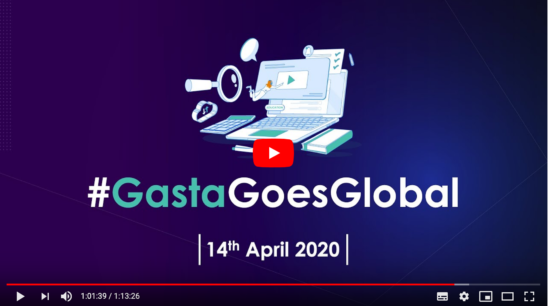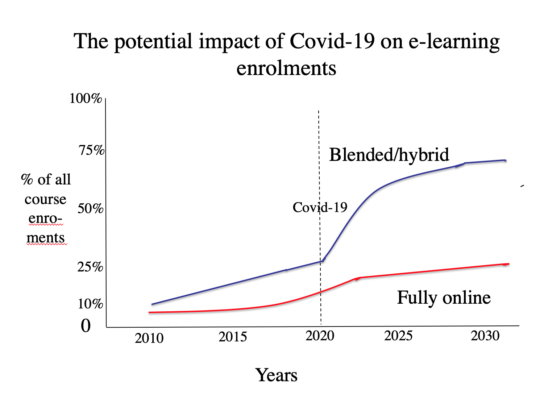GastaGoesGlobal
I really enjoyed participating in Tom Farrelly’s ‘GastaGoesGlobal’ yesterday. This was an online multi-person presentation in the Irish ‘Gasta’ style, where every presenter had just five minutes, and the participants counted down in Gaelic 5-4-3-2-1 to introduce and end each presentation. The topic was Covid-19 and the future of online learning, and Zoom and YouTube streaming were used. The full recording is available at https://www.youtube.com/watch?v=vfrc4AEzYc8. My presentation comes at about 55 minutes into the recording, and I was about the only one who ran out of time, but all the other presentations are well worth watching.
Making predictions
There is probably nothing more foolish than trying to predict the future, except perhaps trying to quantify it, but because the Gasta was a mad Irish idea in the first place, I decided to have a go anyway. I tried to put some numbers on how fully online learning and blended/hybrid learning are likely to change, post Covid-19.
These predictions are informed by the results of the last three CDLRA annual surveys of online learning in Canadian post-secondary education, so they probably apply in any case just to Canada, but I also need to say these are personal projections and are not endorsed by the CDLRA. Also they represent the past, which as everyone knows is not a good basis for future predictions, three years is not a good basis for identifying longer-term trends, and the data collected has all kinds of limitations. So is my back sufficiently covered? Probably not.
Nevertheless, I do believe that there is some justification for my predictions, and in particular, they have significant policy implications for institutions if anyone finds my conclusions credible.
Where we are today
Fully online (distance) enrolments
Before Covid-19 struck, approximately 10 per cent of all course enrolments in Canadian credit programs at university and college level were in fully online courses, and online enrolments overall had been increasing by about 10 per cent per annum, although there were significant variations between provinces (CDLRA, 2017, 2018, 2019). So without Covid-19 we could have expected growth to continue at a slow but steady rate over the next few years.
Blended/hybrid learning
More difficult to track is the extent of hybrid learning, defined as some reduction of face-to-face teaching to incorporate more online or digital learning. This is something really that requires a survey of faculty as this has tended in the past to be an instructor-driven decision. However, in the CDLRA annual surveys, institutions have been asked to make an estimate of the extent of hybrid learning.
In 2017, 78% of institutions reported less than 10% of courses were in a blended/hybrid mode. In 2018, on the other hand, 76% of the 151 institutions answering this question reported that they offer some courses using a blended/hybrid delivery methodology, 40% reported an increase from the previous year, and 49% expected further increases in blended/hybrid learning the following year. Although the estimates are vague, we can again see a tendency for blended/hybrid learning to increase from year to year.
The impact of Covid-19
Well, we all know that, don’t we? All hell broke loose, campuses were closed half-way through a semester and suddenly everyone was scrambling to move to ’emergency remote teaching.’ Many commentators have argued that this is not the same as online learning, although online learning in the sense of teaching through the internet is certainly a major component.
What we can be sure of is that many instructors who have never been involved in online learning before have had a crash course in moving to ’emergency remote teaching.’ Some will have found it to be a disaster, others will have taken to it like a duck to water, but in most cases, some things will have worked and some things won’t have. Nevertheless a much greater proportion of instructors will now have been exposed to online learning in one form or another, and that in itself is likely to be an important barrier that has been crossed for many faculty.
Enrolments post-Covid-19
Let’s cut to the chase. Here are my predictions in the graph below:
Fully online
You can see fully online learning chugging along growing at around 10% per year until 2020, then there’s a bit of an accelerated increase over the next couple of years, because of Covid-19, then it reverts back to a slower growth from 2025. It is likely to continue to grow gently beyond 2030, mainly because of lifelong learning and immigration, where people in the workforce and with families increasingly need further skills and qualifications in an increasingly automated world. In the meantime campus-based enrolments are likely to decrease because of fewer students coming through from high school, due to demographics. For some institutions, then, fully online learning will become important for maintaining enrolment numbers.
Blended/hybrid
However, it is in blended/hybrid learning where we are going to see the big increase. As instructors have become more familiar with online and digital learning through emergency remote learning, they will begin to integrate it more and more into their regular teaching. They will, without external intervention, learn gradually by trial and error what is best done in class and what is best done online. In particular, the move towards more skills development will drive instructors to more use of digital tools such as serious games, VR, and for enabling students to practice online, through computerised testing, etc..
Furthermore, we know from the CDLRA surveys that more than half of all Canadian institutions are implementing or have developed a strategic e-learning plan, and this will also provide further support and encouragement for faculty to move into some form of blended learning.
As a result I see a big jump in 2021 and 2022, slowing down a little later but still growing quickly until a plateau of around 70-75% of all course enrolments are in blended/hybrid classes. The rest, for a variety of reasons, will still remain as mainly on-campus teaching.
There will almost certainly be differences in timing from my prediction but I have more confidence about the general shape of the lines in the graph. In other words we may get to 75% of all courses in a blended/hybrid mode more quickly or more slowly than predicted, but the end point is still likely to be in the 70-80% range.
Policy implications
I see this rapid growth, particularly in blended/hybrid learning, as having serious policy implications for institutions, which I will discuss in the next post tomorrow.











 Dr. Tony Bates is the author of eleven books in the field of online learning and distance education. He has provided consulting services specializing in training in the planning and management of online learning and distance education, working with over 40 organizations in 25 countries. Tony is a Research Associate with Contact North | Contact Nord, Ontario’s Distance Education & Training Network.
Dr. Tony Bates is the author of eleven books in the field of online learning and distance education. He has provided consulting services specializing in training in the planning and management of online learning and distance education, working with over 40 organizations in 25 countries. Tony is a Research Associate with Contact North | Contact Nord, Ontario’s Distance Education & Training Network.


Thanks a lot for showcasing your views on this.
What about the macro-level changes to the finances of post-secondary institutions? These would have to be a part of any predictions on the future of any modality of education.
Absolutely, Norman, but I have no idea how this will play out (and is likely to vary considerably by province). I suspect most institutions will see a significant net drop in income over the next few years, but how that will influence institutional or even government policies regarding online learning is anyone’s guess. Maybe we will have a better idea in a few months time.
Nice views on education, How to reach rural areas where online education is still developing. Developing countries like India